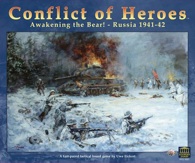Conflict of Heroes – Boardgame Review
 Conflict of Heroes: Awakening the Bear! Russia 1941-42. Academy Games. Designed by Uwe Eickert. $75.00.
Conflict of Heroes: Awakening the Bear! Russia 1941-42. Academy Games. Designed by Uwe Eickert. $75.00.
Passed Inspection: A solid game design that plays smoothly.
Failed Basic: A bit pricey for an introductory-level wargame.
Two hits will destroy any unit, and hits on units call for a random chit draw to determine the effect.
As I get older, I find more and more that simplicity is key for an enjoyable game. Finding kindred spirits to play with who also have time on their hands has become more difficult, and the marathon gaming sessions of my younger days are far less frequent now. So it’s with no small amount of pleasure that I played through Conflict of Heroes: Awakening the Bear! Russia 1941-42. Clearly the publisher needs a lesson in writing short, catchy titles, but that’s about the only thing I found lacking in this simulation of Russian Front combat.
{default}This is a game that emphasizes skirmish-level conflicts in the Great Patriotic War. Featuring one-inch square counters, five modular, mounted map boards, and a stack of random event cards, Conflict of Heroes provides a booklet of 10 different scenarios with a decent variety of combined-arms deployment. The scenarios range from a five-on-five infantry firefight with machine-gun support on both sides all the way up to scenarios with tanks, mortars, demolition charges, bunkers and other defensive emplacements, supply trucks and Molotov cocktails. Each scenario spells out the turn sequence in its introduction.
Every unit has a basic allotment of seven Action Points (AP), used for movement, attack and/or rallying. Each counter shows the number of points required for any given unit to attack, as well as that unit’s attack and defense strength scores. These scores are different depending on the type of attack (small arms have no effect on armor, for example) and, for an armored vehicle, defense ratings are higher if it is attacked through its front. Movement is handled with a simple point-based system; moving through difficult terrain costs more points.
In addition to the seven basic AP, each side receives Command Activation Points (CAPs) that can be expended for opportunity fire, reaction movement, etc. They can also be used to purchase one random event card per turn that can swing the balance of power in either direction by giving a player extra Command Activation Points, denying points to the other side, or introducing special events. A scenario’s introduction tells players how many CAPs each side receives for that scenario. These CAPs simulate quality of training and preparedness; the side that is better prepared receives more CAPs, and that can make a huge difference at critical moments.
Each scenario has its own set of victory conditions, but it’s also possible to win on victory points alone by eliminating enemy units or holding crucial positions just long enough. Two hits will destroy any unit, and hits on units call for a random chit draw to determine the effect: tanks can be rendered immobile or unable to fire; infantry can be pinned or panicked; and anything can be destroyed with a one-hit lucky shot, though at somewhat long odds.
Designed by Uwe Eickert, Conflict of Heroes is a fast-playing, straightforward wargame. Even the more complex scenarios will still be easy to understand after players have run through one or two of the simpler missions. The first scenarios in the booklet can be played in an hour or less. As more elements are added (vehicles, defensive emplacements, artillery) the game naturally becomes more complex and turns take longer to resolve. The game has very reasonable solitaire suitability, as combat damage is resolved with random chit draws, though hidden units might be more problematic in a solitaire game.
This game has a great deal going for it —it’s fast-paced and full of action without bogging down over needlessly complicated rules. Suitable for up to four players, Conflict of Heroes has sturdy, quality components and clearly written rules of play. The modular map boards can be rearranged in many ways to provide additional play value for future scenarios or to inspire the players to come up with their own. The starting age listed is 10 and up, and this would be an excellent game to use when playing with younger or inexperienced gamers. The title suggests that this may turn into a series, and I for one am hoping the publisher will turn next to the Pacific Theater.
[gallery:198]Bill Bodden has been in the hobby game industry for over twenty years, including stints in the retail, distribution and publishing sectors. His short fiction was nominated for an Origins Award in 2003, and he contributed to the Origins Award-winning book Hobby Games: The 100 Best. He currently serves as sales manager for Green Ronin Publishing, and is a part-time freelance writer. A complete goober for miniatures, he paints them on rare occasions when he has spare time. Bill lives in Wisconsin with his wife, their four cats, and a whole lot of games.
ACG Intel


0 Comments
Trackbacks/Pingbacks